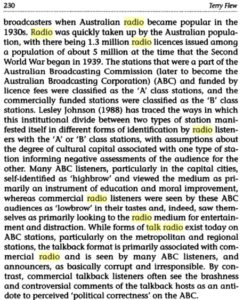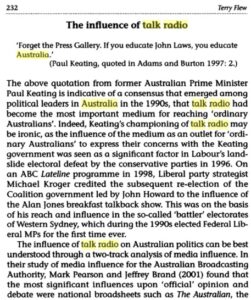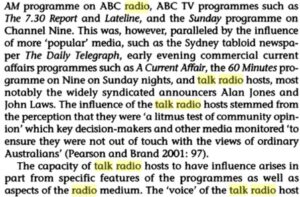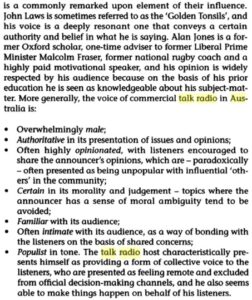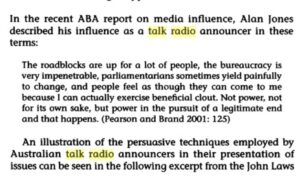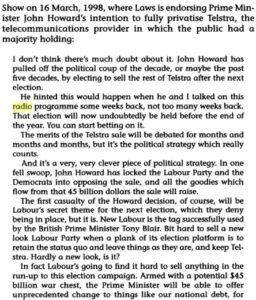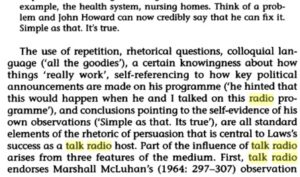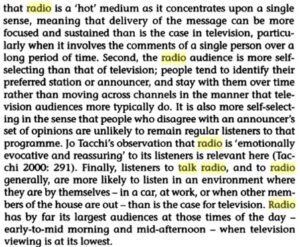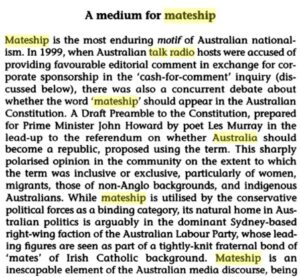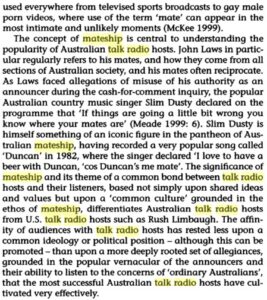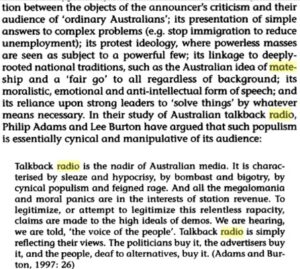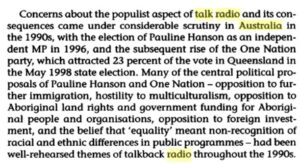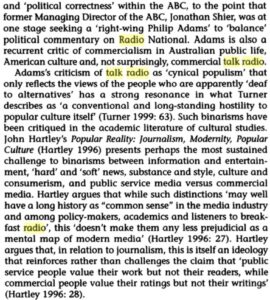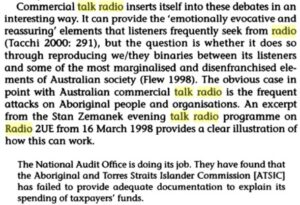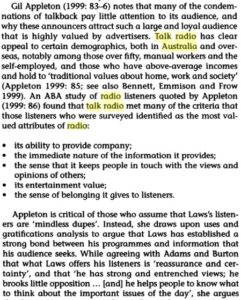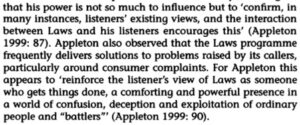When you are an actor, you are performing, and sometimes in the course of performance, you can allow natural parts of yourself to come through.
As a radio host, you are also performing, but you can often allow large parts of yourself to come through that would recognizable by friends and family.
I’ve rarely had anyone who knew me comment that my performance on Youtube was unrecognizable to them.
Dr. Helen Wolfendon writes in 2012:
* There is a standard piece of advice that talk radio presenters almost always get when they start working on-air: “Just be yourself”. It sounds easy, especially when you hear people every day who are good at it. But more often than not, as soon as you are sitting in the studio by yourself, trying to talk into the microphone, the words that come out and the way they come out sound nothing like you expect – or the way the advice suggests. There are exceptions to this; people who can step up to the microphone and sound as if they have been there forever. But for many people it is a struggle – and with good reason. The advice belies the complexity of the task at hand.
* The modern style of radio presentation has been described as “personality radio” (Geller, 1996; Guilfoyle, 2002). This refers to broadcasters who build a relationship with their audience, based on embedding their authentic self – their personality – into their on-air presentation. These presenters are highly desirable to radio managers because, the theory goes, they attract and keep audiences. The reality is likely to be much more complicated than that. Personality has always been a nebulous term and the “self” is also a tricky concept to unpack. But given that a radio presenter’s livelihood will depend on it, it is worth delving into the complexities.
* The essence of the problem is contained within the expression, “Be yourself”. It assumes that human beings have a single identity, a single personality. “Be yourself”, in the singular, does not leave any space for more sophisticated understandings of self, which have long gone beyond the unitary (Blumer, 1969; Cooley, 1922; Mead, 1934; Sullivan, 1953). So it would be reasonable for a presenter to ask: “Which self?” Added to the unitary self is the implied requirement for the “authentic” self. Montgomery illustrates the complexion of authenticity within a broadcasting context:
“Because broadcast talk by its nature takes place in the mediated public sphere, it is frequently – to a greater or lesser extent – staged for performance: and the performed character of the talk displays itself in various ways – for instance, in the pre-allocation of turns, in the reactions of a studio audience, or in a perceived sense of scriptedness. ‘Authentic talk’ in the public sphere might, by contrast, be seen as the reverse of this. It is a condition to which some kinds of broadcast talk aspire, in which traces of performance are effaced or supressed.” (2001, pp. 397-8)
* For the first decade of the 21st century, the ABC’s approach to presentation was encapsulated by the highly naturalistic imperative of “personality radio”. There had been a move away from the more remote, “objective” and authoritative presentation tradition inherited from the BBC. Now presenters were being encouraged to tell their own stories, to bring their lives and experiences into the programme content, and to allow listeners to build a connection with a “real” person – to have a “conversation” with the listener. Why the shift? The authentic self, as embodied by the conversational presentation style, is attractive to radio producers and station managers, “presumably because its verbal forms project in the public sphere in a cluster of values widely held to be desirable: egalitarianism, informality, intimacy, greater possibilities for participation, and so on” (Montgomery, 2001, p. 398).
* The radio studio is a very strange environment. As a presenter, your job is to sit in an often padded room, in front of a microphone and a complicated technological console, and speak to—as Paddy Scannell describes it—the “unknown, invisible absent listeners”. This is a challenge which Scannell describes as the “fundamental communicative dilemma for broadcasters” (2000, p. 10). But even though the radio “product” is produced in this strange environment, for the listener who hears it in his or her everyday listening context, it must feel warm and familiar.
* off-air, the appropriate self deployed to match social circumstances is much more automatically drawn out or elicited by the social context. By comparison, the on-air context, at least initially, has much or all of that information missing. What a presenter is required to do is appropriate his or her understandings from off-air social contexts to apply on-air…
* Jon Faine produces fresh talk by working largely unscripted. Faine presents Mornings and The Conversation Hour on 702 ABC Melbourne. Faine is something of a stalwart in the ABC and several participants reference him in their interviews and consider him a role model.
HW: Do you think of the on-air work as a performance?
JF: Oh there’s no doubt it is… Geoff Rush was on The Conversation Hour one day and at the end of it we sort of had a bit of a chat and you know I was star struck and terribly excited and he said “No no no. What I do,” – this is Geoffrey Rush speaking, he said – “someone writes a play and I learn it. I rehearse it for several weeks and then I perform it for maybe an hour and a half in front of three or four hundred people, night after night after night, for a season. And I think that’s hard.” He said, “But what you do, no one writes anything for you, you don’t have a rehearsal, you perform for three and a half hours live, in front of hundreds of thousands of people, and then you do a completely different show the next night, the next day.” (J. Faine, interview, January 23, 2008)
Faine is able to contrast his own performance with that of an actor – even better, he is able to have the actor, who is one of Australia’s finest, do the job for him. This exchange between Faine and Rush can be considered in the context of two people who are at the top of their respective crafts, contrasting the different elements of performance in each of their practices. Faine demonstrates the authenticity of his performance by highlighting the freshness of the content as well as the talk and the unrehearsed delivery. Faine would generally consider himself to be the “animator” and the “author” of his performance, but not always the “principal”. He recognises that the nature of the role means that sometimes he “has to ask the mongrel question”. Faine says, “I’m performing a role. I don’t mean performing a role theatrically, I mean performing a role in society. It’s… the ABC’s obligation and role of keeping people accountable in decision making…” He says that he is “not a belligerent person but on-air [he] can be” (ibid).
* The elements of unpredictability and risk are inversely proportionate to the familiarity of the space, and it is reasonable to claim that the more desirable kinds of “authenticity” become more available as a presenter becomes more relaxed and familiar with their programme.
* As a radio presenter you have a job to do, an obligation to the people who have bothered to switch you on. If you are in the chair, no matter what your personal dramas are at that point in time, you still have to meet your responsibilities to the audience and of course, the organisation who is paying you. It is a more complicated “set
of observers” that a presenter has to serve than just the “invisible absent listener”. Fidler also recognises that the fact that “it could all go horribly wrong at any given time” is part of the authenticity of the performance.
* James Valentine is the presenter of Afternoons on 702 ABC Sydney. Valentine offers a particularly articulate description of what is happening on-air:
JV: You’ve always got to think about it from the point of view of the listener. Here’s a person stuck in traffic with an AM radio in their dashboard. What does this sound like? And so unless you’re thinking about it in that sort of perspective all the time then you’re not going to be creating interesting things that come out of the dashboard and soon as you’re thinking like that you’re thinking as a performer thinks. That’s what performers think like.
According to Valentine, you effectively “perform as yourself” which is not the same as “being yourself”. “Performing yourself” further complicates the notions of authenticity and naturalness inherent in the “be yourself” injunction. Valentine points out that it takes time to learn how to do it; to become familiar with this strange social context and to work out an appropriate self for it. He says “With all of these sort of things, what… increases is your base level. The more you do it the higher your base level gets.” He also recognises that the presentational self must at some level, be other-directed, because it is only through reciprocity that the presenters needs are met.
JV: “I’ve got the biggest ego in the world, you know, but I also know that that ego’s not going to get served unless I’m there for the audience and unless I understand what the audience is wanting. And unless…it’s all about them. If I make it all about them I get my jollies.”
* Talk radio presenters in the ABC are often on-air for shifts of two hours, some as long as six. Over this daily duration, five days a week, forty weeks a year, it is difficult to sustain a self that is highly alien to the selves used in other social contexts.
* from a presenter perspective, it is critical that the presentation does not sound like performance – and in some cases cannot feel like a performance either.
So what is it? It is clear that for these presenters, there is an active projection of the self for the audience: a “best” self, a self at the top of their form. As in all such presentations of the self, the projection is a function of the relationship, and what the presenter would like the relationship to be, and what it will be allowed to be by their audience. The relationship is not of a friend or confidante or family member or new person you-met-at-a-party, though no doubt presenters cannibalise any or all of these for the purpose at hand. The relationship is of broadcaster to audience. The audience is known through the presenters’ own history in the community of listeners, through conversations with talkback callers, outside broadcasts, and the sheer imaginative cast of emotionally intelligent minds. This audience is understood and related to in the same instant as individual and community, and in the constantly shifting play of gender, class, culture, geography, in-group and out-group nuances within a conversation which is sometimes actually two-way, but is more often a complex and reflexive interactive process in which the audience can only be imagined.


